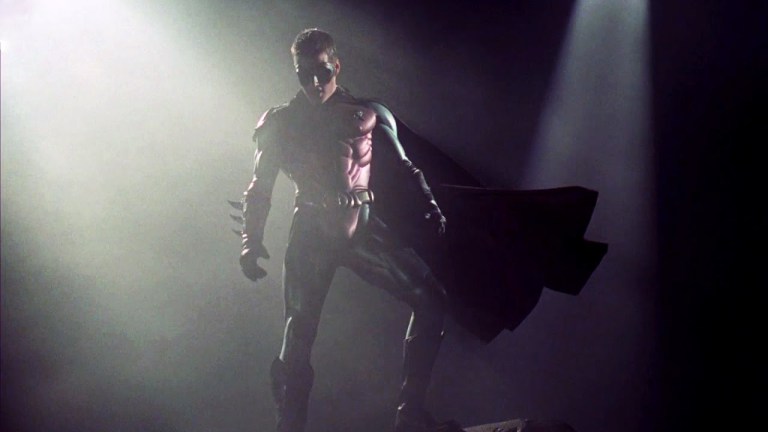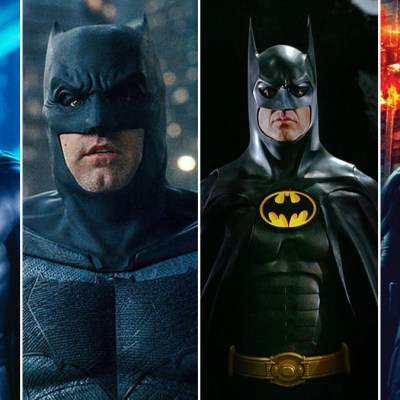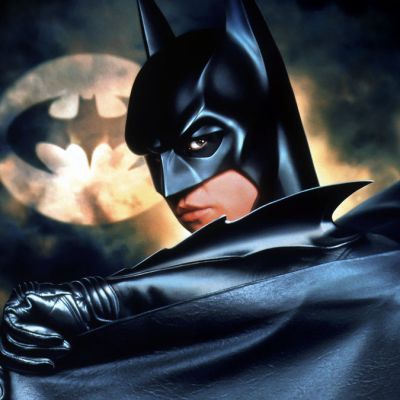How Batman Forever Got Robin Right
The generally reviled Batman Forever got one thing right: a thoroughly modern live action version of Robin.

A quarter century after its release, Batman Forever remains perhaps the most divisive of the Caped Crusader’s 10 big-screen appearances to date. It is certainly the fulcrum on which the entire history of the series balances: the point where the franchise changed course in pursuit of instant gratification and success, only to pave the way for abject failure and supreme rebirth.
The back story of Batman Forever has been well documented before, so here it is in brief in case you were napping: following the less than stellar box office returns of Tim Burton’s 1992 Batman Returns — a Gothic fever dream which frightened not just children but Warner Bros. Pictures’ corporate partners like McDonald’s — the studio brain trust decided a change was in order.
Burton would not be back to direct a third Batfilm; that task was bequeathed to Joel Schumacher, who was mandated to bring a lighter, more playful vibe to the proceedings. Schumacher’s stated goal was to make a “living comic book,” but he seemed to conflate the Batman comic books — which had grown in sophistication over the decades — with the Batman 1960s TV series, a deliberate campfest that, while fun in its own way, was the dominant image that entire generations had of the Bat.
“I didn’t want to look at what Tim did and try to be different,” said Schumacher at the time to Daily Variety. “I wanted to do my own thing.”
Schumacher went all in on creating what was essentially a big-screen version of the Adam West series (arguably combined with elements of the comics from the 1940s and 1950s). It was nearly a 180-degree shift from the darker, more subversive trappings of the two Burton films that had come before. Batman Forever was maligned by fans who felt that the Burton movies had finally gotten the character out from underneath the massive shadow of the TV series. But the movie did not pretend to be what it wasn’t, and it did have its positive aspects.
For one — and we’ve argued this before — the screenplay by Lee and Janet Scott Batchler and Akiva Goldsman is easily the best of the four films made between 1989 and 1997. What the Burton films possessed in style and imagery, they lacked in narrative cohesion or story structure. Batman Forever was a different animal: establishing one villain right in the opening sequence, it did away with too many tedious origin stories and left room for a better fleshed out story and arcs for the rest of the characters, cartoon-like as they might have been.
Val Kilmer, replacing Michael Keaton after two films, was a potentially strong Batman, more dynamic and central to the story than the character had been in the Burton films. Brooding less over the death of his parents, he still brought gravitas and presence to the role. While Tommy Lee Jones and Jim Carrey didn’t just chew the scenery but swallowed it whole as Two-Face and the Riddler respectively, both were given motivations and plans that were not too far off from their comic book counterparts.
Yet Batman Forever’s greatest strength — and the source of some of the movie’s best beats — is the way it handles the origin story of Robin, a.k.a. Dick Grayson, played by Chris O’Donnell.
The introduction of Robin into the movie franchise had been hotly debated since the development of the first film. According to Bruce Scivally’s Billion Dollar Batman, early scripts for what eventually became the 1989 movie Batman featured Dick Grayson to varying degrees, with all of them having the young acrobat taken in by Bruce Wayne late in the story, after his trapeze artist parents are murdered by the Joker.
Although DC Comics and Warner Bros. Pictures had initially mandated that Dick/Robin be included in the movie, Tim Burton and screenwriter Warren Skaaren wrote him out while working on the script in 1988. “Ultimately it was too much psychology to throw into one movie,” Burton told Rolling Stone in 1989. “If there’s another movie, Robin would have to be established at the beginning, not to be crammed into the third act.”
That became an issue in the sequel, Batman Returns, as well, where initial drafts of the script reinvented Robin first as a feral child living under the streets of Gotham City and then as a young black mechanic who helps the Dark Knight get out of a jam when the superhero crashes the Batmobile into his garage. The latter version of the character was even cast, with Marlon Wayans getting the nod before the part was again written out of the movie.
“I got my wardrobe fitted and everything, and what happened was that there were too many characters, and they felt Robin wouldn’t be of service,” Wayans told The A.V. Club. “So they put me in the third one, and when the third one came around, they got a new director on it and their vision of the project changed. They decided they wanted somebody white to play Robin.”
There were more problems with the character of Robin than just how to fit him into already crowded movies. With the emphasis in the Burton films on a darker version of Batman, both the filmmakers and the studio couldn’t get past the campy look and tone of Robin established by Burt Ward in the TV show. “We would lift our arms up and say, ‘Let’s have them both go to Frederick’s of Hollywood to pick out that little green costume,’” joked Tim Burton to Starlog about his attempts to give the character a redesign.
Even DC was struggling with how to handle Robin after the success of both the first Batman and Frank Miller’s classic The Dark Knight Returns graphic novel, with the books now on a mission to prove they were as “mature” as Miller’s gritty reinterpretation. With Dick Grayson off on his own as Nightwing, that led to the death of the second Robin, Jason Todd, in the comics, as fans voted by a slim margin to kill him off in a nationwide poll. The third Robin, Tim Drake, got a new costume, dispensing with the bare legs and little green shorts for a look that would foreshadow the movie version.
When it came time to make Batman Forever, it was determined that Robin’s moment to step forward had come. “Dick Grayson’s story is much more interesting than I’d ever seen it portrayed,” Schumacher told the New York Times about the character’s debut in his movie. “Because of the TV series, he was seen as this kind of asexual, cartoony, wholesome airhead.”
The movie retells Robin’s back story almost directly from the comics, with some modifications. Dick himself is somewhat older than he was first presented on the page, probably around 17, and he’s got some attitude as well as a fondness for motorcycles. His family is a troupe of acrobats who are killed during a raid on their circus by Two-Face, with Dick heroically disposing of a bomb while his parents and older brother die below — leaving him an orphan in a mirror scenario of what happened to Bruce Wayne.
Dick is dropped off at stately Wayne Manor after Bruce says he’ll take the kid in, and the conflict between the two is immediately apparent and neatly set up: Dick understandably wants vengeance on Two-Face, while Bruce recognizes their common link and knows that revenge will only lead to more grief for the sole surviving Grayson. When Dick discovers the existence of the Batcave under the mansion, their already tense relationship is strained to the breaking point.
Dick wants to partner with Bruce/Batman, seeing a role with the Caped Crusader as both a way to track down and kill Two-Face while simultaneously giving himself a new direction in life. Bruce can only see the loneliness and danger of the life he leads, and doesn’t want his young charge to follow him down that same path. He’s even willing to quit being Batman (for a few scenes anyway) to prevent Dick from utilizing the resources of the Bat on his own.
The scenes in which Bruce and Dick face off — with Alfred (the always great Michael Gough, returning from the Burton films) as sly referee — are the finest in Batman Forever and some of the best in all four Burton/Schumacher films. For one thing, they feel like the comics without being overly campy, and they effectively move the relationship between Bruce and Dick forward — the only time, in fact, that any relationship involving Bruce Wayne in any of the four films feels somewhat real and not just tacked on.
Their battle of wills comes to a head after Dick saves Batman’s life during an assault by Two-Face, proving not just his courage but his natural heroic abilities. And yet Bruce refuses to budge, until an even more deadly invasion of Wayne Manor and the destruction of the Batcave forces Bruce’s hand. He must don the cowl again, and this time Dick, with some accoutrements provided by Alfred, is ready to assist — and Bruce is ready to accept his help. The shot of Batman and the newly christened Robin shaking hands and sealing their partnership is one of the few in the original four films that feels kind of legendary.
It’s a satisfying payoff in a series that feature few such moments. It gives Kilmer his best scenes in his sole outing as Batman, and it also presents a Robin that retains the character’s underpinnings while giving him a more updated sensibility (that cringeworthy “holy rusted metal, Batman” line aside). Robin’s obsession with Two-Face is also resolved as he elects to save Harvey Dent’s life instead of killing him. The original Robin costume is nicely redesigned and given its proper homage, even as the Boy Wonder gets a sleek, more contemporary outfit (aside, of course, from the wholly unnecessary nipples).
Make no mistake, Batman Forever is no one’s idea of a great film. It’s an intermittently entertaining movie and a take on the Dark Knight that is clearly more of a flashy corporate product after the experimentation of the flawed Burton entries. But if there’s anything from the film that still works 25 years later, it’s the birth of the Dynamic Duo — the only time (at least for now) that we’ve seen the genesis of that iconic partnership play out on the big screen.


